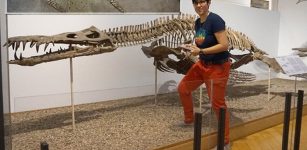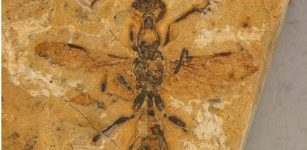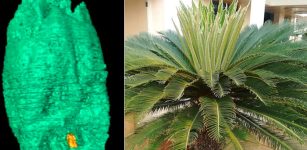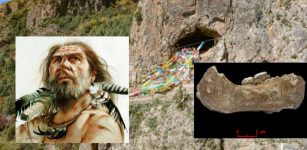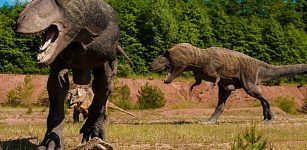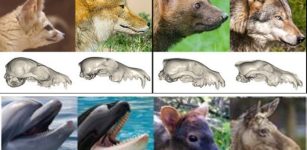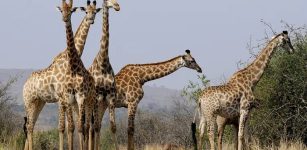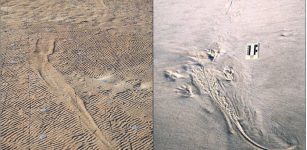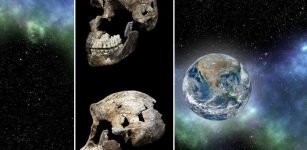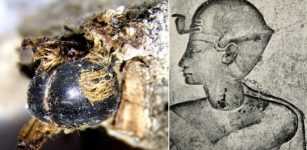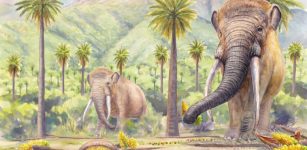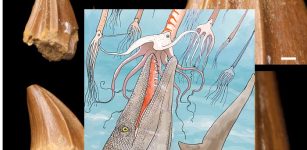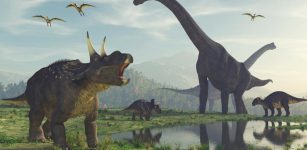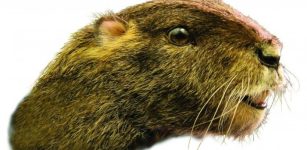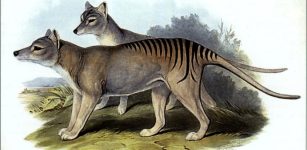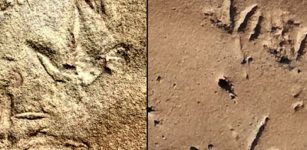Why Ancestors Of Modern Birds Survived When All The Dinosaurs Died
Eddie Gonzales Jr. - AncientPages.com - Fossils reveal how ancient birds molted their feathers.
Every bird you’ve ever seen— every robin, every pigeon, every penguin at the zoo— is a living dinosaur. Birds are the only group of dinosaurs that survived the asteroid-induced mass extinction 66 million years ago.
Illustration of what a newly hatched Enantiornithine bird may have looked like. Photo: Yu Chen and Shundong Bi.
But not all the birds alive at the time made it. Why the ancestors of modern birds lived while so many of their relatives died has been a mystery that paleontologists have been trying to solve for decades. Two new studies point to one possible factor: the differences between how modern birds and their ancient cousins molt their feathers.
Feathers are one of the key traits that all birds share. They're made of a protein called keratin, the same material as our fingernails and hair, and birds rely on them to fly, swim, camouflage, attract mates, stay warm, and protect against the sun’s rays. But feathers are complex structures that can’t be repaired, so as a means of keeping them in good shape, birds shed their feathers and grow replacements in a process called molting. Baby birds molt in order to lose their baby feathers and grow adult ones; mature birds continue to molt about once a year.
“Molt is something that I don't think a lot of people think about, but it is fundamentally such an important process to birds, because feathers are involved in so many different functions,” says Jingmai O’Connor, associate curator of fossil reptiles at Chicago’s Field Museum. “We want to know, how did this process evolve? How did it differ across groups of birds? And how has that shaped bird evolution, shaped the survivability of all these different clades?” Two of O’Connor’s recent papers examine the molting process in prehistoric birds.
A paper in the journal Cretaceous Research published in May 2023 detailed the discovery of a cluster of feathers preserved in amber from a baby bird that lived 99 million years ago.
Today, baby birds are on a spectrum in terms of how developed they are when they're born and how much help they need from their parents. Altricial birds hatch naked and helpless; their lack of feathers means that their parents can more efficiently transmit body heat directly to the babies’ skin. Precocial species, on the other hand, are born with feathers and are fairly self-sufficient.
Left: Feathers from a baby bird that lived 99 million years ago, preserved in amber. Photo by Shundong Bi. Right: Illustration of what a newly hatched Enantiornithine bird may have looked like.
All baby birds go through successive molts— periods when they lose the feathers they have and grow in a new set of feathers, before eventually reaching their adult plumage. Molting takes a lot of energy, and losing a lot of feathers at once can make it hard for a bird to keep itself warm. As a result, precocial chicks tend to molt slowly, so that they keep a steady supply of feathers, while altricial chicks that can rely on their parents for food and warmth undergo a “simultaneous molt,” losing all their feathers at roughly the same time.
The amber-preserved feathers in this study are the first definitive fossil evidence of juvenile molting, and they reveal a baby bird whose life history doesn’t match any birds alive today. “This specimen shows a totally bizarre combination of precocial and altricial characteristics,” says O’Connor, who was the first author of the paper alongside senior author Shundong Bi of the Indiana University of Pennsylvania. “All the body feathers are basically at the exact same stage in development, so this means that all the feathers started growing simultaneously, or near simultaneously.” However, this bird was almost certainly part of a now-extinct group called the Enantiornithines, which O’Connor’s previous work has shown were highly precocial.
O’Connor hypothesizes that the pressures of being a precocial baby bird that had to keep itself warm, while undergoing a rapid molt, might have been a factor in the ultimate doom of the Enantiornithines. “Enantiornithines were the most diverse group of birds in the Cretaceous, but they went extinct along with all the other non-avian dinosaurs,” says O’Connor. “When the asteroid hit, global temperatures would have plummeted and resources would have become scarce, so not only would these birds have even higher energy demands to stay warm, but they didn’t have the resources to meet them.”
Meanwhile, an additional study published July 3 in Communications Biology by O’Connor and Field Museum postdoctoral researcher Yosef Kiat examines molting patterns in modern birds to better understand how the process first evolved.
In modern adult birds, molting usually happens once a year in a sequential process, in which they replace just a few of their feathers at a time over the course of a few weeks. That way, they're still able to fly throughout the molting process. Simultaneous molts in adult birds, in which all the flight feathers fall out at the same time and regrow within a couple weeks, are rarer and tend to show up in aquatic birds like ducks that don’t absolutely need to fly in order to find food and avoid predators.
It’s very rare to find evidence of molting in fossil birds and other feathered dinosaurs, and O’Connor and Kiat wanted to know why. “We had this hypothesis that birds with simultaneous molts, which occur in a shorter duration of time, will be less represented in the fossil record,” says O’Connor— less time spent molting means fewer opportunities to die during your molt and become a fossil showing signs of molting. To test their hypothesis, the researchers delved into the Field Museum’s collection of modern birds.
“We tested more than 600 skins of modern birds stored in the ornithology collection of the Field Museum to look for evidence of active molting,” says Kiat, the first author of the study. “Among the sequentially molting birds, we found dozens of specimens in an active molt, but among the simultaneous molters, we found hardly any.”
While these are modern birds, not fossils, they provide a useful proxy. “In paleontology, we have to get creative, since we don’t have complete data sets. Here, we used statistical analysis of a random sample to infer what the absence of something is actually telling us,” says O’Connor. In this case, the absence of molting fossil birds, despite active molting being so prevalent in the sample of modern bird specimens, suggests that fossil birds simply weren’t molting as often as most modern birds. They may have undergone a simultaneous molt, or they may not have molted on a yearly basis the way most birds today do.
Both the amber specimen and the study of molting in modern birds point to a common theme: prehistoric birds and feathered dinosaurs, especially ones from groups that didn’t survive the mass extinction, molted differently from today’s birds.
“All the differences that you can find between crown birds and stem birds, essentially, become hypotheses about why one group survived and the rest didn’t,” said O’Connor. “I don't think there's any one particular reason why the crown birds, the group that includes modern birds, survived. I think it's a combination of characteristics. But I think it's becoming clear that molt may have been a significant factor in which dinosaurs were able to survive.”
Written by Eddie Gonzales Jr. – AncientPages.com - MessageToEagle.com Staff



